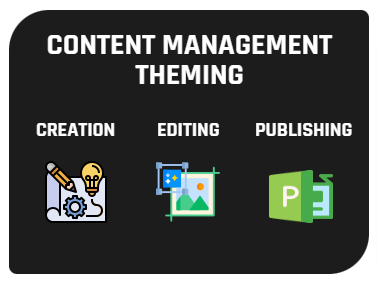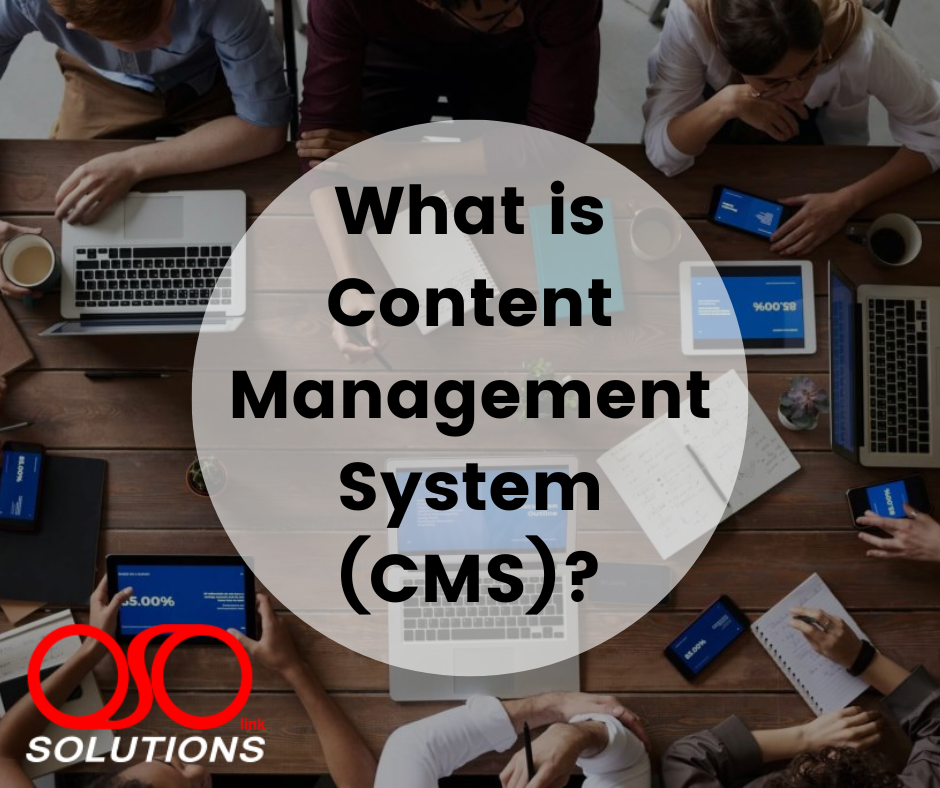Content Management System (CMS), is a software application that enables users to create, edit, collaborate on, publish and store digital content. CMSs’ are typically used for enterprise content management (ECM) and web content management (WCM).
When you think about running a website, you might get visions of geeky programmers typing away at code. And yes, the foundation of every single website is code.
However, with a content management system, you’re able to ignore the code and focus on the more fun parts of running a website, like creating content and CMS marketing.
So how does it work? While things obviously differ depending on which content management system you choose, you’ll normally get some type of dashboard where you can manage all the important aspects of your site.
For example, let’s say that you want to complete some CMS marketing by adding a blog post. All you need to do is type the blog post in your content management system’s text editor.
Then, your chosen CMS will handle putting together all the underlying code so that visitors from around the world can read your blog post.
Now that you can answer the question of what is a content management system, let’s get into some examples of the most popular content management systems for building a website.
How Does a Content Management System Work?
From that CMS definition, all content management systems:
- Are digital. They’re applications used on computers, sometimes offline, but more frequently online.
- Help users create, format, edit, and publish content. This may include support for media, written content, or drop quotes based on the CMS; but the core idea is that you can make and publish some sort of content.
- Store the content in a database. Again, the supported database and hosting types vary from CMS to CMS; but the content always gets logged inside a database.
- Give access to multiple users. One CMS may have unique user permissions, while another might allow for specific editor, author, and admin roles.
- Present the content. As mentioned, this usually happens on the frontend of a live website, but some content management systems allow for private or even offline publication.
What to Look For in a CMS?
When conducting your research on content management systems, we recommend looking for the following features:
- A powerful content editor with both visual and code-based editing options. It’s also nice to see drag-and-drop builders.
- Core CMS functionality like the ability to add, format, and publish content, while also incorporating user roles.
- Access to third-party themes, plugins, and integrations for improving your site.
- CMS marketing features or integrations for things like email marketing, social media, and coupons.
- Ecommerce capabilities to potentially sell products.
- Flexibility with your design. This includes mobile responsiveness and custom code control.
Great Content Management System (CMS) Examples:
- WordPress
- Joomla
- Drupal
- Adobe Commerce Powered by Magento
- Squarespace
- Wix
- Ghost
- Shopify

WordPress
WordPress is by far the most popular content management system. In fact, the WordPress CMS powers 42.9% of all the websites on the internet.
There are a ton of reasons WordPress is so popular. It’s free to download and use. It’s also easy to learn, flexible, and search engine friendly. Plus, thousands of themes and plugins make it one of the most customizable platforms. That definitely aligns WordPress with our core CMS definition and more!
Joomla
Joomla is a free-to-use CMS that has an impressive set of features baked into it and supports 70+ languages. It’s a good fit for any website that needs comprehensive content management, especially educational sites or complex websites like social networks.
Several front-end and back-end templates are available to help you build a solid foundation. What sets Joomla apart is the extensive user groups and user management options, and many built-in features like search management and CMS marketing tools. You’ll also be able to collect and manage user consent.
It is developer-friendly. At the same time, it offers a user-friendly interface, making it true to our CMS definition.
Drupal
After WordPress, Drupal is the second most popular CMS. If you ask tech-savvy folks what is a content management system, they’ll most likely cite Drupal as an example. That’s because it’s the one CMS that requires the most technical chops.
Drupal is also free, though you’ll need your own hosting. With an advanced administration panel, it gives complete control of the content presentation and user and permission management. Out of the box, it’s fast loading, secure, and supports 100+ languages. Ready-made templates for different industries like tourism and eCommerce make website-building easier for users.
While beginners may be better off skipping this CMS, developers should have no trouble building outstanding websites.
Adobe Commerce Powered by Magento
If your sole focus lies in eCommerce, Adobe Commerce (powered by Magento) offers a complete CMS marketing, online store, and content publication solution. It comes in two versions – a free open source community version, and the premium service sold by Adobe. What makes it attractive to large businesses is its top-notch speed, security, and scalability. Throw in multisite support, and it can be the perfect platform for any business that needs distinct sections, such as chain stores.
The fast checkout and easy integration with major payment solutions will surely delight online store owners. So will the intuitive admin interface, analytics out of the box, themes, and CMS marketing extensions. However, unlike WooCommerce users, Adobe/Magento users may require basic web development knowledge. But that’s really no reason keen learners shouldn’t try it, considering it aligns perfectly with the CMS definition we outlined earlier.
Squarespace
Squarespace is a ready-to-use solution for building just about any kind of website. It’s so simple, anyone can make a website – physical store owners, professionals, bloggers, artists. Besides that, it comes with intuitive social media and CMS marketing integrations, as well as a drag-and-drop builder, beautiful templates, and one of the cleanest dashboards you can find.
If all that you need is an easy way to build an attractive website, Squarespace is your pick. You’ll not need to worry about technicalities or wonder what is a content management system. Instead, you can focus on content creation and quick, easy CMS marketing.
Squarespace is a paid tool. Though you get to choose from a wide range of impressive templates and modules, you’re pretty much stuck with what you get. The templates themselves are optimized to suit all types of websites.
Unlike the previous tools, Squarespace is a hosted website builder, so you don’t need to purchase your own web hosting. Everything comes packaged in for a monthly fee.
Wix
Wix’s step-by-step wizard turns website building into a fun activity. The Wix setup guides you through the template selection process, ensuring you get a template that’s appropriate for your website. It also integrates social media and includes blogging features. Nonetheless, you’ll be stuck with a Wix-branded website, unless you’re willing to pay to remove the branding.
Ghost
If all that you’re looking for is a clean writing experience for both bloggers and readers, try Ghost. It allows you to focus on writing your posts. It’s user-focused, with a minimal interface, and uses Markdown in the Editor. You can choose from dozens of pre-made themes, use the free, built-in membership functionality, and manage email newsletters directly from the dashboard.
You can choose between the freely-downloadable self-hosted version and a premium version on Ghost’s servers. Ghost also takes care of basic social sharing and SEO.
Ghost is a wonderful CMS solution for publishing a blog, online magazine, newsletter, or for any creator who needs the most powerful integrations and publishing tools. The Ghost user showcase clearly displays that some of the top brands in the world find Ghost exceptional.
Shopify
Shopify users sign up for the platform and pay a monthly fee to receive the entire website builder, shopping cart functionality, and website launch necessities like hosting, a domain name, and an app store for expanding upon your design.
Content management systems don’t only focus on blogging and content creation. Many of them (like Adobe/Magento listed earlier) offer a well-rounded ecommerce content management environment for building an online store, designing product pages, and including everything else you would want on a website like a blog, FAQ page, shipping information, and customer support portal. Shopify is just that, offering a complete CMS marketing and ecommerce platform without the need to find your own hosting.
Shopify isn’t strictly for bloggers or creatives, but for individuals and brands interested in selling digital or physical products online. That could very well include bloggers and creatives, but you definitely wouldn’t use Shopify for just posting content like videos or articles. However, it’s by far the easiest CMS to build a website to sell products, especially for non-developers.
How to Get Started With Your Chosen CMS?
Except for Squarespace and Wix, all of these content management systems are self-hosted. That means to get started with one you’ll need to:
- Purchase web hosting
- Install the CMS software on your hosting
- Configure the settings to control the CMS marketing, style, overall functionality.
—
Read more of our blogs.
Source: https://themeisle.com/blog/
“No copyright infringement is intended”

Read more Blogs
Learn more about us. Feel free to contact us.


